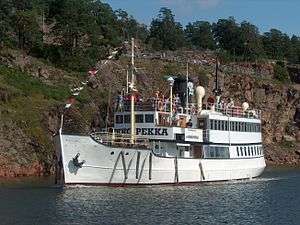Screw steamer

A screw steamer or screw steamship is an old style term for a steamship or steamboat, powered by a steam engine, using one or more propellers, also known as screws, to propel it through the water. Such a ship was also known as an 'iron screw steam ship'.
In the 19th century, this designation was normally used in contradistinction to the paddle steamer, a still earlier form of steamship that was largely, but not entirely, superseded by the screw steamer.[1]
The screw or propeller was first developed by Swedish inventor John Ericsson for the U.S. Navy. Ericsson was the principal designer of the monitor class of vessels.
Many famous ships were screw steamers, like the RMS Titanic and RMS Lusitania. These massive leviathans had three or four propellers. Ships under two-hundred meters usually only had two or one propellers.[2]
See also
References
- ↑ Canney, 1998 pp.11-13
- ↑ Canney, 1998 pp.26-27
Bibliography
- Canney, Donald L. (1998). Lincoln's Navy: The Ships, Men and Organization, 1861-65. Naval Institute Press. p. 232.
External links
